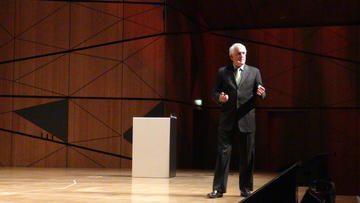Chris Bradshaw walked attendees of Autodesk University Germany through the challenges and opportunities facing design professionals today in digital fabrication, ambient intelligence, and infinite computing.
By Tom Lansford
Professional designers have challenges every day: technical challenges, business challenges, people challenges. Most of us are thinking about the immediate, pressing challenges that must be dealt with today. When we are fortunate enough to have a chance to pause and reflect, we might work on those other short-term and mid-term challenges. Very rarely do we focus on the macro-level changes occurring around us and our business.
Attendees at the recent Autodesk University Germany event got a chance to think about three trends that can have an immediate impact on their work. Autodesk Chief Marketing Officer Chris Bradshaw shared his company’s view on how digital fabrication, ambient intelligence, and infinite computing are impacting design.

Bradshaw’s keynote was a brief gift of time and information about the macro-level changes taking place. These trends are starting to change the way we work, change the expectations of our customers, and most importantly, fundamentally change the way the world around us works.
Digital fabrication refers essentially to 3D printing. The capabilities of 3D printing continue to grow and expand. 3D printers are providing more capabilities and more materials for printing needs. 3D printers have an ever expanding price range with desktop 3D printers now as cheap as $1500. And 3D printer developments are creating machines that can work in environments as varied as home and office to zero gravity. There are 3D printers which can print replacement parts for themselves, and researchers are working on 3D printers capable of printing replacement organs for human transplant.
Ambient intelligence is the trend in which sensors are becoming ubiquitous and where sensors are being used to deliver information, data, or let’s call it environmental intelligence or the sensor web; it is technology to gather performance intelligence on all kinds of systems surrounding us today. Small examples about products we use today include new products from Nike, which has added sensors to a line of their sports shoes which analyze your use of the shoe. The Bay Bridge in San Francisco is being rebuilt with thousands of sensors to provide information about the bridge’s state and performance. In the spaces around us, it is possible to paint sensors onto walls to deliver feedback about the space in question. Sensors are becoming smaller and more ubiquitous, delivering new abilities to monitor everything we build, construct, manufacture, and maintain.

Infinite computing is not only a trend, but a reality of our daily lives already. First of all, even your mobile phone today has more computing power than the space shuttle which the Americans just retired. Secondly, thanks to the cloud, every one of us has instant access to an affordable and practically unlimited amount of computing power. Take a generic computing problem which requires about 10,000 seconds to complete on a single processor. Today you can solve the same problem on 1000 processors in 1 second for the same cost. Computational power is one of the most abundant, affordable resources available today to solve problems. How we utilize this in our own work is the key as many of us still approach our problems using the old computing model.
Bradshaw reminded his audience that Autodesk expects these three trends will continue to impact their customers today and tomorrow. In the current product direction and research coming from the design software experts, Autodesk is embracing these trends through their own cloud-based product offerings and their collaboration with experts in 3D printing. A priority of the company appears to be managing the impact and complexity of these changes within the current and future product offerings such that their tools will remain powerful and relevant to the professionals who design, build, manufacture and create the products which we use and which entertain us daily.
Contributing Writer Tom Lansford is Editor of CADplace.uk and CADplace.fr, GraphicSpeak and CADplace occasionally share articles.





